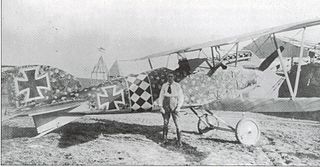
Hauptmann Wilhelm "Willi" Reinhard was a German pilot during World War I. Reinhard became a flying ace during the war, credited with 20 confirmed aerial victories. After commanding two successive fighter squadrons, he was picked to replace Manfred von Richthofen as commander of Jagdgeschwader 1 when the Red Baron fell in combat. Reinhard died on 3 July 1918 while testing a prototype fighter.

Eduard Florus Harald Auffarth Royal House Order of Hohenzollern, Iron Cross, Silver Wound Badge, Hanseatic Cross, was a World War I German fighter ace credited with 29 victories. After the war, he ran an aviation training school that covertly supported establishment of the Luftwaffe.
Leutnant Hermann Becker, was a World War I German flying ace credited with 23 victories.
Friedrich Altemeier was a German World War I flying ace credited with 21 confirmed aerial victories. Due to his distinguished faithful military service and piloting skills, he became one of the test pilots for Germany's last and best fighter airplane of the war, the Fokker D.VIII.

OffizierstellvertreterLeopold Rudolf Reimann was a World War I flying ace credited with five aerial victories.
LeutnantLudwig Luer was a German World War I flying ace credited with six aerial victories.
OffizierstellvertreterErich Schütze was a World War I flying ace credited with six aerial victories.
Leutnant Fritz Gerhard Anders was a World War I flying ace credited with seven aerial victories. He was the world's first night fighter ace.
OffizierstellvertreterWilhelm Kühne was a World War I flying ace credited with seven confirmed aerial victories and five unconfirmed ones.
OffizierstellvertreterWilli Kampe was a World War I german flying ace credited with eight aerial victories.

VizefeldwebelFritz John Jacobsen was a German World War I flying ace credited with eight confirmed and two unconfirmed aerial victories.
Unteroffizier Paul Hüttenrauch was a World War I flying ace credited with eight aerial victories.
LeutnantWilhelm Anton Seitz was a German World War I flying ace credited with 16 aerial victories. He scored those victories over a two-year span, beginning on 17 November 1916 and ending on 4 November 1918.
Leutnant Viktor von Pressentin von Rautter was a German World War I flying ace credited with 15 aerial victories.
Leutnant Hans von Freden was a German World War I flying ace credited with 20 aerial victories.
Oberleutnant Hans Bethge HoH, IC was a German pilot who was one of the first World War I flying aces, as well as an aerial commander. He was credited with 20 aerial victories. He was also a squadron commander for the unusually long term of fourteen months.
Leutnant Johannes Max Janzen was a World War I flying ace credited with thirteen aerial victories. He returned to Germany's military service during World War II, and died in a Russian prison camp on 18 October 1945.
OffizierstellvertreterOtto Esswein was a German World War I flying ace credited with twelve aerial victories.
Leutnant Hans von Keudell was a World War I flying ace credited with twelve aerial victories.
Royal Prussian Jagdstaffel 39, commonly abbreviated to Jasta 39, was a "hunting group" of the Luftstreitkräfte, the air arm of the Imperial German Army during World War I. The unit would score 68 aerial victories during the war, including 14 observation balloons downed. The squadron's victories came at the expense of seven pilots killed in action, one killed in a flying accident, five wounded in action, and one taken prisoner of war.




